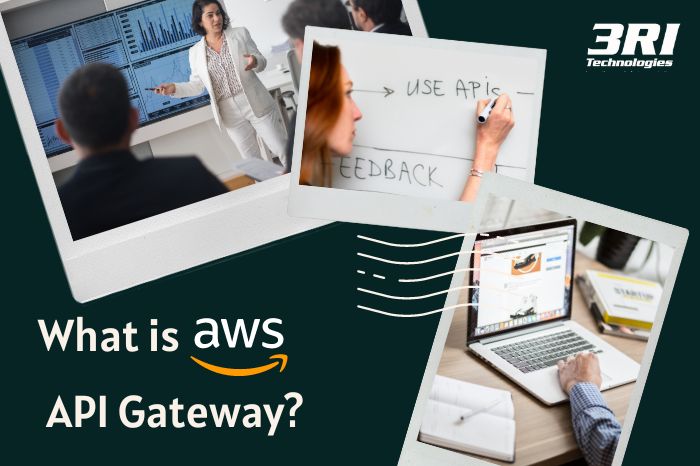Amazon API Gateway is described as wholly managed services developers use for publishing, creating, maintaining, securing, and monitoring APIs at different scales. Eventually, APIs work like a front door to provide access to different data, business logic, or functionality for various applications. API gateway is proficient in handling all kinds of tasks involved in the process. There is no minimum fee or startup costs involved in the API gateway.
In short, an API gateway can easily handle numerous interactions between websites, mobile applications, or the web.
Unique features of AWS API Gateway
Interested to begin a career in AWS? Enroll now for AWS Training in Pune.
What is an API gateway?
AWS offers API gateway services and is used for creating, implementing, and maintaining different websites’ APIs. Its underlined features are –
- It can transform both headers and the body for receiving API requests.
- API Gateway helps convert the body and headers of output API responses so that it becomes easy to match with the needs of API.
- Another feature of this gateway is controlling the Amazon Identity and Access Management.
- It can also activate the Amazon integration.
- The implementation of API in different stages allows the differentiation between test, development, version, and production.
- The custom domains can be connected with API.
- API gateway also works by defining various models for response conversions of API.
These features can excellently define the functioning of AWS API Gateway and descry be what is amazon API gateway elaborately.

Get FREE career counselling from Experts !
How does AWS API Gateway work?
API business is obviously business critical and has its unique way of working.
- Pattern
Majorly, API gateways make use of proxy patterns. In this, the gateway works by listening to the incoming AI requests that come to a service visible by an application.
- Non-functional capabilities
A gateway is meant to add non-functional capabilities from securing and monitoring API to transformation and mediation. The effectiveness of gateways depends on how they will deliver the non-functional capabilities.
One prime principle needs to be followed: a separation of process, transport, policy, and binding style.
Enroll in our AWS Online Training today!
- Enforcement of policy
Generally, a gateway outlines the API as an abstract interface implemented by a process, including output and input messages. Hence, a gateway can describe various API styles and enforce the policies for every message, transport, or style.
What is the requirement of API Gateway?
Before learning API Gateway, initially, it is essential to understand the requirements of API Gateway. Here are some of the factors that define it better.
- Case study
To understand this, think about a case study compromising a complex page of an e-commerce application. While looking on an Amazon product listing page, you will find the information required for a specific page.
- The problem
The microservices are generally deployed on various servers in case the users want access to such services. When a client uses all the services, it is supposed to separate the Ratings and Reviews microservices. With just one call, clients can get reviews.
- The solution
In the API Gateway approach, a layer between microservices and clients is known as API Gateway. You can find it as a front-facing service used by clients looking to access the microservices.
All these points are enough to explain why there is a need for API Gateway and what is API gateway AWS.
Check out AWS Cloud Practitioner Training and get certified today.

Meet the industry person, to clear your doubts !
Highlighted benefits of AWS API Gateway
AWS API Gateway is best for those willing to develop microservices because it helps minimize the impact. Indeed, it provides enormous benefits to developers; some of them are listed below –
- Offer competent API development
API gateway helps run multiple versions of similar APIs at once. This allows for quick testing and release of a new version. The users must pay for more calls generally made to APIs and transfer the data.
- Monitoring becomes easy
Monitoring includes:
- API call information and metrics.
- Error rates.
- Data latency must be checked regularly.
This can quickly be done using an API gateway.
- High performance
API gateway offers the minimum possibility of latency for API responses and requests. Thus, it can accelerate the traffic and ensure that backend operations must support the increase in traffic.
- Flexible services
The services offered by API gateway don’t ask you to pay any monthly or annual subscription. Also, the users don’t have to pay anything or the minimum service cost. By this, one can take the maximum benefits of API gateway.
- API Caching
With an API gateway, one can get access to caching features despite the API backend for every call. It helps increase performance and minimize latency. The size of the cache determines the cost of API services.
- Improve security
The developers can set the API to request authorization and further authenticate the API access. Moreover, the API gateway provides OIDC and OAuth2 support to the developers.
All these mentioned advantages of AWS API Gateway make it easy for developers to complete their projects without facing much trouble.
Sign up for the best AWS and DevOps Course!
What is the role of API gateway in microservices?
Many of you must be wondering what an API gateway in microservices is. AWS API Gateway plays an integral role in microservices.
Microservices is available as an architectural style used to develop various software systems. It structures an application having a vast collection of more minor independent services.
API Gateway acts as a layer present between microservices and client apps. It works to perform like a proxy and accept requests get from different clients. Then, it includes sending API calls to particular internal services. Every microservice list the details associated with API gateways, such as location, port address, name, and others.

Do you want to book a FREE Demo Session?
The reason behind the need for an API gateway for microservices
- Creating abstraction
At the time of creating a microservice application, there are many other microservices involved in this. Receiving a single call requires dozens of services that cause complexities. The clients are concerned about getting a direct and reliable experience. API Gateway works as an abstraction between backend services and clients.
- Orchestrates
With the API Gateways, the developers create a route depending on headers, hostname, path, and other needed information without thinking about any errors.
- Organizing
API Gateways allow developers to troubleshoot different problems in a faster manner with the help of real-time analytics and metrics. Moreover, the API Gateways also allow the backend developers to improve the traffic rate and ensure that the API performance increase continuously.
- Maintainability
API Gateways are proficient in handling service discovery. Along with this, it also helps in upgrading, redesigning, and modernization of API.
Hence, the API gateway works best when clients start mapping an API call to a particular microservice.
API gateways, also known as edge microservices, are used in different applications. Such applications are known to be developed using modern architecture, i.e., microservices. These include autonomous, independent, and single-function components. Once the requests for information are converted into an application, the API gateway will start providing a streamlined approach for retrieving the data.
What’s The Point of An API Gateway?
In contemporary software architectures, an API gateway is an essential element as a central entry point for overseeing, directing, and safeguarding communication among diverse microservices, programs, and external systems. Its primary responsibility is to make managing Application Programming Interfaces (APIs) in dispersed contexts simpler and more efficient.
API Gateways provide several essential features:
Request Routing: By providing a single API, they streamline the client’s engagement with the system by forwarding incoming API requests to the relevant microservices or backend services.
Load balancing: They provide fault tolerance, scalability, and optimal performance by dividing incoming traffic equally among several instances of the same service.
Protocol Translation: Incoming requests can be translated between protocols via API Gateways, allowing services with disparate communication standards to communicate with one another.
Security: To guard against unauthorized access and misuse, they include vital security features such as rate limitation, authentication, and authorization.
Monitoring and Analytics: By gathering and evaluating usage data, API Gateways assist enterprises in understanding traffic trends, system performance, and possible problems.
Caching: To lessen the strain on backend services and speed up response times, they can cache responses.
Transformation: To accommodate data types or adhere to particular specifications, API Gateways might alter API requests or answers.
As a traffic cop for APIs, API gateways manage, optimize, and protect data flow between clients and backend services—a critical function for creating secure, dependable, and modern applications.
Which API Categories are Supported by the Amazon API Gateway?
Amazon API Gateway provides support for the two API types listed below:
1. RESTful APIs
These application programming interfaces (APIs) talk to a server using HTTP methods like GET, POST, PUT and DELETE. These are the same ways that are utilized in order to access online sites, as well as to generate a resource or carry out an action. RESTful APIs are used for serverless workloads that Amazon API Gateway manages, while HTTP APIs are used to manage HTTP back ends.
2. WebSocket API
This application programming interface (API) enables the creation of communication channels that are bidirectional over a single Transmission Control Protocol connection. It makes client-server communication easier in real-time applications like online gaming, web chat, and stock trading platforms, among other things. In contrast to more conventional HTTP APIs, which require the client to make the first move in a communication exchange, the WebSocket API enables the server to deliver messages to the client even when the client has not specifically requested those messages.
3. What Exactly is API Caching?
- You can cache the responses from your endpoints by enabling API caching in Amazon API Gateway.
- The amount of calls that are made to your endpoint can be decreased through the use of API Caching, which also helps to lower the latency of the queries made to your API.
- When API caching is enabled, API Gateway will save the responses received from your endpoint in its memory for a time measured in seconds that you can configure. Instead of making calls to your endpoint, API Gateway will look up the response in the cache when it receives a response request.
4. Architecture of API Caching
Assume that we have people calling API Gateway with their requests. The API Gateway will send a trigger to a Lambda function, after which the Lambda function will send the response back to the API Gateway. Now that a new user has arrived and made the same API call to API Gateway, we have turned on caching in addition to the time-to-live (TTL) setting. Let’s say that the TTL is sixty seconds. Because of this, the response has been lingering within the API Gateway for the last minute. Because the response to that request has already been cached, you do not need to invoke the Lambda function to fulfill the request of another user at this time. Because of this, we can obtain a response from the end users in a significantly shorter time.

5. The API Gateway’s features
- Reasonably Priced
Given that an API gateway offers a tiered price structure for API queries, it is incredibly economical and practical. An API request can be purchased for as little as $1.51 per million requests, and you can reduce expenses by making fewer requests.
- Scalable
You don’t need to be concerned about Autoscaling groups or EC2 service handling API requests. An API gateway expands on its own.
- Throttling and Caching
The most crucial component of API Gateway is caching. By caching the endpoint’s answers, you can reduce the latency of your API requests. It also has a significant role in determining the service’s cost.
Additionally, you can guard against security threats to your API Gateway. You can set up a throttle service to limit requests in order to thwart assaults and stop the flow of fraudulent API calls to the API Gateway.
- Adaptable
You do not need to start an EC2 instance or configure the Gateway software in order to use the API Gateway. Using the AWS Management Console, API Gateway may be set up in minutes.
- Connecting CloudWatch
A monitoring service called CloudWatch is linked with an Amazon API Gateway. This tool tracks failures, latency, and metrics from incoming API calls.
- Protection
It’s possible to grant access to your APIs. By using several authorization options like the Lambda function and Identity Access Management service (IAM), API Gateway is utilized to check incoming requests. An IAM is connected to a gateway that offers resources like secret keys and AWS credentials to access an API. After tokens are successfully validated using a Lambda function, access to an API is made available. Check out DevOps with AWS Training offered at 3RI Technologies which has 30% Theory class and 70% practical hands-on training.
6. AWS API Gateway Architecture
It is the gateway between all the connected services in the AWS ecosystem and is written in Node.js. This allows it to be configured as the backbone of the AWS Cloud, which is fitting given that it is the gateway.
Only Amazon Web Services (AWS) customers can use the Amazon API Gateway, a software-as-a-service (SaaS) offering created in Node.js. Within the context of the AWS ecosystem, Amazon API Gateway may be compared to a backplane.
The API gateway, in conjunction with AWS Lambda, makes up the portion of Amazon’s serverless architecture that interacts directly with customers. Lambda runs the code on the highly available and fully controlled computing infrastructure. Still, the API gateway is the component that is responsible for exposing those endpoints to the necessary services.
API Gateway enables efficient proxy integrations with AWS Lambda and HTTP endpoints. These interfaces are necessary to allow serverless applications.
Among its many features are:
- Create, implement, and oversee APIs
- Adaptability
- Lifecycle management for APIs
- SDK development
- monitoring of API operations
- Authorization for AWS
- Third-party developers’ API keys
Amazon API Management Components

7. Amazon API Management Components
API management platforms provide support for the API architecture as well as the data that lies beneath it. They include gateways among the many components that are incorporated into the layered architecture that they use. Other components of API administration include the following:
Developer interface for APIs. Developers can access the documentation and other information connected to an API through a centralized location known as an API developer portal. The portal provides access to various resources and instruments, including SDK, forums, and API keys. It provides API developers with assistance in building, testing, and operating the API.
Reporting and data analysis are included. The gathering and analysis of usage statistics is an essential component of API management. Data such as requests per second, request volume, latency, and throughput are examples of metrics that are included in usage analysis.
Utilizing this data, organizations are better able to measure the success of their API programs.
Management of the API lifespan. The steps involved in the creation and upkeep of an API are referred to together as the API lifecycle. The process starts with the design of the application programming interface (API) and continues with the development, testing, and deployment of the API. The API will be retired, bringing the lifetime to a close. Management of APIs can be made more accessible with the assistance of a variety of tools and recommended procedures.
Manager of the API policy. This component is in charge of controlling the policies that are used to administer and define the API. The policies follow the same path through their lifecycle that the API itself does, beginning with design and ending with retirement. These policies manage the traffic to the API as well as its performance and security. Management platforms typically offer pre-configured policies that may be implemented without the need to write any new code or make any alterations to the back-end services.

Want Free Career Counseling?
Just fill in your details, and one of our expert will call you !
8. Implementing the AWS API Gateway
To start, make a Lambda function in the AWS Lambda interface. Then, an HTTP API is made with the API Gateway interface. After that, you use your API.
It sends the request to your Lambda code when you call your HTTP API. Lambda runs the Lambda function, and it replies to API Gateway. After that, API Gateway will send you an answer.
Step 1: Develop a lambda operation.
Select Lambda from the compute services menu.
Select “Create Function”
After entering a function name (‘my function’ in this instance) and leaving the language at its default setting (node.js 14. x), select the ‘Create Function’ button.
A node function is presently being constructed using sample code provided by AWS.js
Step 2: Establish an HTTP API.
Use the AWS console to look for the API Gateway service.
The next task is to develop an HTTP API. Although WebSocket and REST APIs are also offered by AWS Lambda, for the sake of simplicity in this tutorial, an HTTP API should be created.
Click “Add Integration” to incorporate the Lambda function that has been built into the API that we are going to construct.
Choose Lambda from the Integrations dropdown menu, then choose the lambda function you just established. Lastly, give your HTTP API a name, such as “my-http-api.”
Reviewing your integration and the names you’ve given is the next step before clicking “create.”
Step 3: Check the API.
The next step is to test your API to ensure it is operational. To use your API, open a web browser.
Copy and paste this invocation URL into a web browser. Add your lambda function name as indicated.
Your browser is now sending a GET request to the newly built API.
Check the response from your API. In your browser, you should see the words “Hello from Lambda!”
9. Use cases of Amazon API Gateway
- Vogue
Vogue is a well-known publication that covers fashion as well as lifestyle topics. The Amazon API Gateway is utilized by one of its websites, namely PhotoVouge. PhotoVouge is a website specializing in photography that enables people to contribute photographs to their website in the hope that photography agencies will pick up the photographs. The editorial staff will examine each and every picture that is uploaded in order to guarantee the most excellent possible image quality.
The enormous volume of traffic that the Photo Vogue website experienced was the source of the difficulty that the website encountered. The underlying information technology infrastructure of Photo Vouge could not cope with the enormous volume of traffic, and the company intended to provide photographers and editing staff with an improved and more streamlined experience.
To triumph over these obstacles, Along with Amazon CloudFront, which serves as Photo Vogue’s content delivery network, the Amazon API Gateway is now being utilized by the company in the caching layer for the REST API.
- Fox Network
FOX NOW is an established name in the world of television, as we are all aware. Within the FOX Network, there is a team known as the Fox Digital Consumers Group that is responsible for managing the streaming of digital content to customers using set-top boxes, mobile devices, and the web. Both the hosting of the website and the distribution of FOX NOW are handled by containerized microservices that are operated on Amazon Web Services.
To provide a more positive user experience for FOX Digital Consumer Group’s audience, there is an immediate need to enhance the routing of service requests and facilitate inter-service communication. FOX can entirely divorce the front end from the backend content system thanks to using a standard API layer that Amazon API Gateway and Network Load Balancer back. In addition, this backend system is constructed by many teams utilizing a microservice design and is hosted on Amazon Web Services (AWS).
Because of this, the FOX Digital Consumer Group was able to offer streamlined services to the vast number of viewers it serves across all of its platforms.
10. What is the cost of the AWS API Gateway?
When people use your APIs, you pay for Amazon API Gateway fees. You don’t have to pay any fees or deposits upfront. You can use the Amazon API Gateway service for free for up to 12 months. It comes with 750,000 connection minutes, 1 million HTTP API calls, 1 million REST API calls, and 1 million messages.
These are the prices for different APIs after the free tier resources are used.
[elementor-template id=”78273″
HTTP APIs
Pay just for the requests you make to the API. In the Amazon Web Services China (Ningxia) Region, run by NWCD, there is a free tier for HTTP APIs called API Gateway. It is accessible for one million API requests per month for 12 months.
API Calls
- Amazon Web Services India
Requests received (per month) Price (in INR)
First 300 million 120.18
300+ million 107.88
- Amazon Web Services India
Requests received (per month) Price (in INR)
First 300 million ¥ 80.42
300+ million ¥ 72.68
REST APIs
Only pay for the data that is sent out and the API requests that you receive. Additionally, API Gateway offers optional data caching, which is billed at an hourly rate that changes according to the cache size you choose.
API Calls
Requests received (per month) Price (in INR)
First 333 million 329.67
Next 667 million 273.85
Next 19 billion 232.73
Over 20 billion 148.20
Costs of Data Transfers
When you send data to the Internet, you will be charged the EC2 data transfer rate.
Caching
You can optionally provision a specialized cache for each step of your APIs for improved speed and quicker API execution. You won’t be locked into any long-term agreements when you indicate the amount of the cache you need; instead, you will be billed hourly for each stage’s cache.
Cache Memory Size (GB) Price (Beijing/Ningxia)
0.5 2.16
1.6 4.21
6.1 19.02
13.5 22.44
28.4 43.40
58.2 85.32
118 170.65
237 341.29
WebSocket APIs
Only messengers sent and received, as well as the total number of connection minutes, are billed. It is permissible to exchange communications with a maximum size of 128 kilobytes (KB). Messages are measured in increments of 32 KB. Thus, two messages are metered for a total of 33 KB.
Message Transfers
Number of Requests (per month) Price (per INR)
First 1 billion 97.74
Over 1 billion 82.25
Minutes of Connections
Every million connection minutes, at 24.49
If you are looking for an Amazon Web Services Course that makes you learn API, then 3RI Technologies is the best institution where you can learn API by attending online classes. Experienced professionals will help every applicant to accomplish their goals and get hired by multinational companies. You can enroll with us now and let your dream come true.
AWS Training Offered In Other Locations Are:
